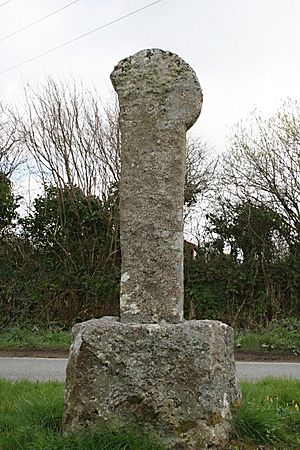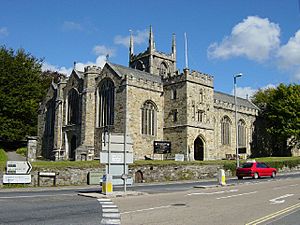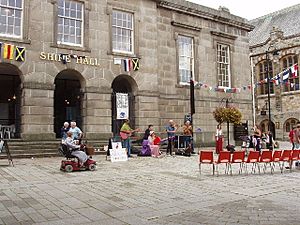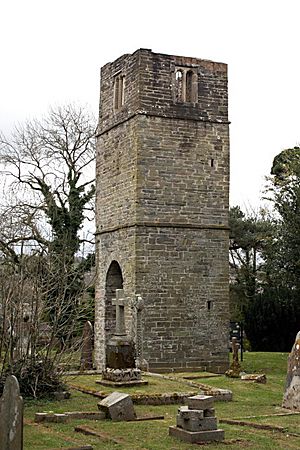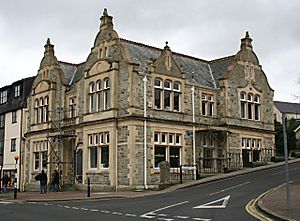Bodmin facts for kids
Quick facts for kids Bodmin
|
|
|---|---|
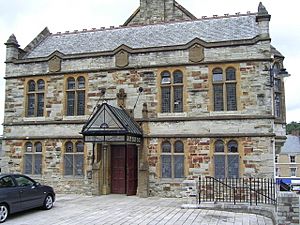 Bodmin Public Rooms (Capitol Cinema) |
|
| Lua error in Module:Location_map at line 530: Unable to find the specified location map definition: "Module:Location map/data/Cornwall (mainland)" does not exist. | |
| Population | 14,736 (Civil Ward, 2011) |
| Demonym | Bodminite |
| OS grid reference | SX071665 |
| Civil parish |
|
| Unitary authority | |
| Ceremonial county | |
| Region | |
| Country | England |
| Sovereign state | United Kingdom |
| Post town | BODMIN |
| Postcode district | PL31 |
| Dialling code | 01208 |
| Police | Devon and Cornwall |
| Fire | Cornwall |
| Ambulance | South Western |
| EU Parliament | South West England |
| UK Parliament |
|
Bodmin (which is Bosvena in Cornish) is a town and local area, called a civil parish, in Cornwall, England. It is located southwest of Bodmin Moor.
The town of Bodmin and its civil parish cover pretty much the same area. This means it is mostly a town, not a countryside area. It shares borders with other parishes like Cardinham to the east and Lanivet to the west.
In 2011, Bodmin had a population of 14,736 people. It used to be the main town of Cornwall, known as the county town. This was before the main courts moved to Truro, which is now the administrative center. Bodmin was part of the North Cornwall District until 2009, when local government changed. The town is now part of the North Cornwall area for the UK Parliament.
The Bodmin Town Council has sixteen councillors. They are chosen every four years. Each year, they pick one person to be the Mayor. The Mayor is the town's leader and runs the council meetings.
Contents
Where is Bodmin and what does its name mean?
The name Bodmin probably comes from the Cornish words "Bod-meneghy." This means "dwelling of or by the sanctuary of monks." Over time, the spelling changed. Some old spellings include Botmenei (around 1100) and Bodman (in 1377). The Bodman spelling was even on old maps from the 16th and 17th centuries.
Small villages and areas like Cooksland, Little Kirland, Dunmere, and Turfdown are also part of the Bodmin parish.
Bodmin's Past
St. Petroc started a monastery in Bodmin in the 6th century. Because of him, the town was sometimes called Petrockstow. After the Norman Conquest (when the Normans took over England), the monastery lost some land. But it still owned many areas, including Bodmin. Bodmin is one of the oldest towns in Cornwall. It was the only large Cornish settlement mentioned in the Domesday Book in 1086.
In the 1400s, the Norman church of St Petroc was mostly rebuilt. It is now one of the biggest churches in Cornwall, after the cathedral in Truro. An abbey for canons (a type of priest) was also built then, but it is mostly in ruins today. For much of Bodmin's history, the tin mining industry was very important for the town's economy.
An old stone found in Lancarffe shows that people lived in Bodmin during the early Middle Ages (a time period from about 500 to 1500 AD). This stone is a memorial to someone named "Duno[.]atus" and is from the 6th to 8th centuries.
There are also several old Cornish crosses in Bodmin. These are stone crosses, often found in Cornwall, that mark special places. One is near the Berry Tower, and another is on Old Callywith Road.
The terrible Black Death plague killed half of Bodmin's population in the mid-1300s. About 1,500 people died. The main local government building was the Bodmin Guildhall on Fore Street.
Rebellions in Bodmin
Bodmin was a key place for three Cornish uprisings.
- The first was the Cornish Rebellion of 1497. A Cornish army, led by Michael An Gof (a blacksmith) and Thomas Flamank (a lawyer from Bodmin), marched to London. They were defeated by the King's army.
- Later in 1497, Perkin Warbeck tried to become King. He was declared King Richard IV in Bodmin. But King Henry VII easily stopped this uprising.
- In 1549, Cornish people and rebels from nearby Devon rose up again. This was because the Protestant King Edward VI tried to make everyone use a new Book of Common Prayer. Many people in Cornwall and Devon still wanted the old Roman Catholic ways. A Cornish army formed in Bodmin and marched to lay siege to Exeter. This was called the Prayer Book Rebellion. In the end, about 4,000 people were killed.
Bodmin's Police Force
From 1836 to 1866, Bodmin had its own police force called the Bodmin Borough Police. This new system replaced the old Parish Constables. It brought paid, uniformed police officers to the town for the first time. In 1857, the Cornwall Constabulary (the county police force) was created. Smaller town police forces were encouraged to join the county force. Bodmin's small police force, which had only two officers, eventually joined the county police in 1866.
"Bodmin Town" Song
The song "Bodmin Town" is an old folk song. It was collected from a Cornishman in 1891 by Sabine Baring-Gould. He later published a version of it in 1924.
Churches in Bodmin
St Petroc's Parish Church
The current church building was built between 1469 and 1472. Until Truro Cathedral was built, it was the largest church in Cornwall. The church tower is from the original Norman church. It used to be 150 feet (46 meters) tall before its spire was lost in 1699. The church has been repaired and restored several times. It is now a Grade I listed building, meaning it is very important historically.
Inside, there are interesting memorials. One is a black Delabole slate memorial to Richard Durant, his wives, and twenty children. Another is for Prior Vivian, which used to be in the Priory Church. There is also a 12th-century ivory casket. People believe it once held parts of St Petroc. The church's font (a basin for baptisms) is also from the 12th century. It is large and beautifully carved from elvan stone.
Other Churches
The Chapel of St Thomas Becket is a ruined 14th-century building in Bodmin churchyard. The holy well of St Guron is a small stone building near the churchyard gate. The Berry Tower is all that is left of the old church of the Holy Rood. There are even fewer remains of the large Franciscan Friary, which was started around 1240.
The Abbey of St Mary and St Petroc is a Roman Catholic church. It was built in 1965 next to an existing seminary (a school for priests). The Roman Catholic area of Bodmin covers a large part of North Cornwall. There are also Catholic churches in nearby towns like Wadebridge and Padstow. The first Roman Catholic mass in Bodmin since 1539 was held in 1881. Besides these, Bodmin has five other churches, including a Methodist church.
Interesting Places to Visit
Bodmin Jail
Bodmin Jail was a prison that operated for over 150 years. Now, it is partly in ruins. It was built in the late 1700s. It was the first British prison to keep prisoners in separate cells, though sometimes up to ten prisoners were in one cell. More than fifty prisoners who were found guilty at the Bodmin Assize Court (a type of court) were executed at the prison.
During the First World War (1918–1919), the prison stored some important documents from Britain's Public Record Office, including the Domesday Book. However, the Crown Jewels were not stored there; they were kept at Windsor Castle during World War II.
Other Important Buildings
Other interesting buildings include the old Shire Hall. This building is now a tourist information center. There are also the Victoria Barracks. These used to be the base for the Duke of Cornwall's Light Infantry regiment. Now, they are home to the regimental museum. The museum shows the history of the regiment from 1702. It has a collection of old weapons, uniforms, and paintings. The Honey Street drill hall was where soldiers met before going to fight in the First World War.
The Bodmin County Lunatic Asylum, later called St Lawrence's Hospital, was a large hospital for people with mental health conditions. It was designed by John Foulston.
Walker Lines was a camp built during the Second World War. It was used to house soldiers who were evacuated from Dunkirk. Later, it held troops getting ready for the D-Day landings. Today, it is an industrial estate but is still known as 'Walker Lines'.
Bosvenna House is an Edwardian manor house. It used to be a hotel and a club for the Royal British Legion. Now, it is a private home.
There is also a large Masonic Hall on St Nicholas Street. It is home to several Masonic groups.
Learning in Bodmin
Bodmin has several schools for different age groups.
Primary Schools
Beacon ACE Academy is a primary school for children aged 3 to 11. It opened in 2017 after two schools merged. It is part of a group of schools called Kernow Learning Multi Academy Trust. The school can have 420 students, plus 30 in its Nursery and 10 in a special class for students with Special Educational Needs.
St Petroc's voluntary aided Church of England Primary School is a large school with about 440 students aged 4 to 11. It was formed in 1990 when two schools combined.
There are two other primary schools in Bodmin: Berrycoombe School and St. Mary's Catholic Primary School.
Bodmin College
Bodmin College is a large state comprehensive school for students aged 11 to 18. It is on the edge of town. The college has a Jazz Orchestra. In 1997, students from Bodmin College built a robot called Roadblock. This robot won the first series of the TV show Robot Wars. The school also has one of the biggest sixth forms (for students aged 16-18) in Cornwall.
Callywith College
Callywith College is a further education college in Bodmin. It opened in September 2017. It is a new college built near the Asda supermarket. Eventually, it will have 1,280 students and 197 staff. It was created with help from the highly-rated Truro and Penwith College. Callywith College aims to provide a great learning experience for young people aged 16-19 from Bodmin and other parts of Cornwall.
Getting Around Bodmin
Bodmin Parkway railway station is a main stop on the Cornish Main Line train route. It is about 3.5 miles (5.6 km) southeast of the town center. Buses leave from outside the station to go to central Bodmin and other towns like Wadebridge and Padstow. A special branch line connects Bodmin Parkway to Bodmin town. This line is home to the local steam railway, the Bodmin and Wenford Railway.
Bodmin is located just off the A30 road. This road connects to the M5 motorway at Exeter, which is about 62 miles (100 km) northeast.
Bus and coach services also connect Bodmin to other areas in Cornwall and Devon.
Sports and Fun in Bodmin
Bodmin has a non-league football club called Bodmin Town. They play in the South West Peninsula League. Their home ground is Priory Park. Bodmin Rugby Club plays rugby union at Clifden Parc.
The Royal Cornwall Golf Club used to be on Bodmin Moor but is now closed. It was founded in 1889.
There is an active running club called Bodmin RoadRunners.
In 2021, Bodmin was a finish point for Stage 1 of the cycling Tour of Britain.
Cornish Wrestling
Bodmin has a long history with Cornish wrestling. The Bodmin Wrestling Association helped create the Cornish Wrestling Association in 1923. At the base of the monument on The Beacon, you can see the remains of a wrestling ring.
More recently, Cornish wrestling tournaments are held as part of the revived Bodmin Riding event. Other places in Bodmin where wrestling tournaments have been held include Coldharbour, Barn Lane, and the Football Ground at Priory Park.
William George Fish, known as "Billy the Fish," was a famous wrestler from Bodmin. He was the featherweight champion in 1927 and 1928, and the lightweight champion in 1933 and 1934.
Media in Bodmin
- Newspapers
The Cornish Guardian is a weekly newspaper published every Wednesday. It has different editions, including one for Bodmin.
In October 2020, the Bodmin Voice newspaper was launched. It is published every Wednesday and focuses specifically on Bodmin news.
- Radio
Bodmin is home to NCB Radio, an internet radio station for North Cornwall. The town also receives county-wide radio stations like BBC Radio Cornwall and Heart West.
- Television
Local TV news for Bodmin is provided by BBC South West and ITV West Country. TV signals come from the Caradon Hill and local relay transmitters.
Famous People from Bodmin
- John Arnold (1736–1799), a famous watchmaker.
- Sir E. A. Wallis Budge, an expert in ancient Egypt and Assyria.
- Thomas Flamank, a lawyer and co-leader of the Cornish Rebellion in 1497.
- William Hamley, who founded the famous Hamleys toy shop.
- Peter D. Mitchell, a Nobel Prize winner, spent the later part of his career in Bodmin.
- Ben Oliver, a record holder in wheelchair racing and ranked among the best in the world.
- Saint Petroc, who founded the monastery in Bodmin.
- Sir Arthur Quiller-Couch, a poet, novelist, and critic.
Town Twinning
Bodmin is twinned with three other places around the world:
- Bederkesa in Germany
- Grass Valley in California, United States
- Le Relecq-Kerhuon in Brittany, France
Official Symbols
W. H. Pascoe's book A Cornish Armory (1979) describes the symbols of Bodmin.
- The town's seal shows a king on a throne.
- The Priory's symbol is three salmon swimming in a blue background.
- The Monastery's symbol has three rings on a blue chevron (a V-shape) between three lion's heads.
Town Events
On Halgavor Moor (also called Goats' Moor) near Bodmin, there used to be an annual carnival in July. King Charles II once attended it.
Bodmin Riding is a traditional annual ceremony. It involves a procession on horseback through the town.
'Beating the Bounds' and 'Hurling'
In 1865–66, the Mayor of Bodmin, William Robert Hicks, brought back an old custom called beating the bounds. This means walking the old boundaries of the town. This event still happens about every five years. It ends with a game of Cornish hurling.
Hurling is a traditional part of beating the bounds in Bodmin. The game starts when the Mayor throws a silver ball into a body of water called the "Salting Pool." There are no teams in this game. The goal is to carry the ball along a set route through the town. The person who carries the ball when it reaches the Turret Clock in Fore Street gets a £10 reward from the Mayor.
The last beating of the bounds and Cornish hurling took place in Bodmin on April 8, 2015. It was organized by the Rotary club of Bodmin.
See also
 In Spanish: Bodmin para niños
In Spanish: Bodmin para niños



